It’s been almost three months since Kylian Mbappé officially departed PSG for Real Madrid in one of the most highly anticipated transfers in recent times.
Naturally, a lot of eyes will have been on how head coach Luis Enrique is adapting Les Parisiens’ attack in a post-Mbappé world, especially considering how impactful the 2018 FIFA World Cup winner was for PSG on the left and centre of attack.
Six games into their first Ligue 1 campaign following the 25-year-old forward’s departure, PSG are undefeated with five wins and one draw in their opening games.
They have scored 20 goals—an average of 3.33 goals per game thus far.
This tactical analysis and team-focused scout report will examine Luis Enrique’s attacking tactics so far this term, focusing on what the ex-Barcelona coach is doing with PSG on the left.
Our analysis will focus on key personnel in relation to PSG’s ruthless start to the season in front of goal, along with some vital elements of the Ligue 1 giants’ overall attacking setup.
Kylian Mbappé & Bradley Barcola Data Analysis
Last season saw Kylian Mbappé play more centrally than perhaps he ever had before for PSG, making way for 2023 summer signing Bradley Barcola to make his way into the team without a massive spotlight on his performances on the left.
Kylian Mbappé Radar Map
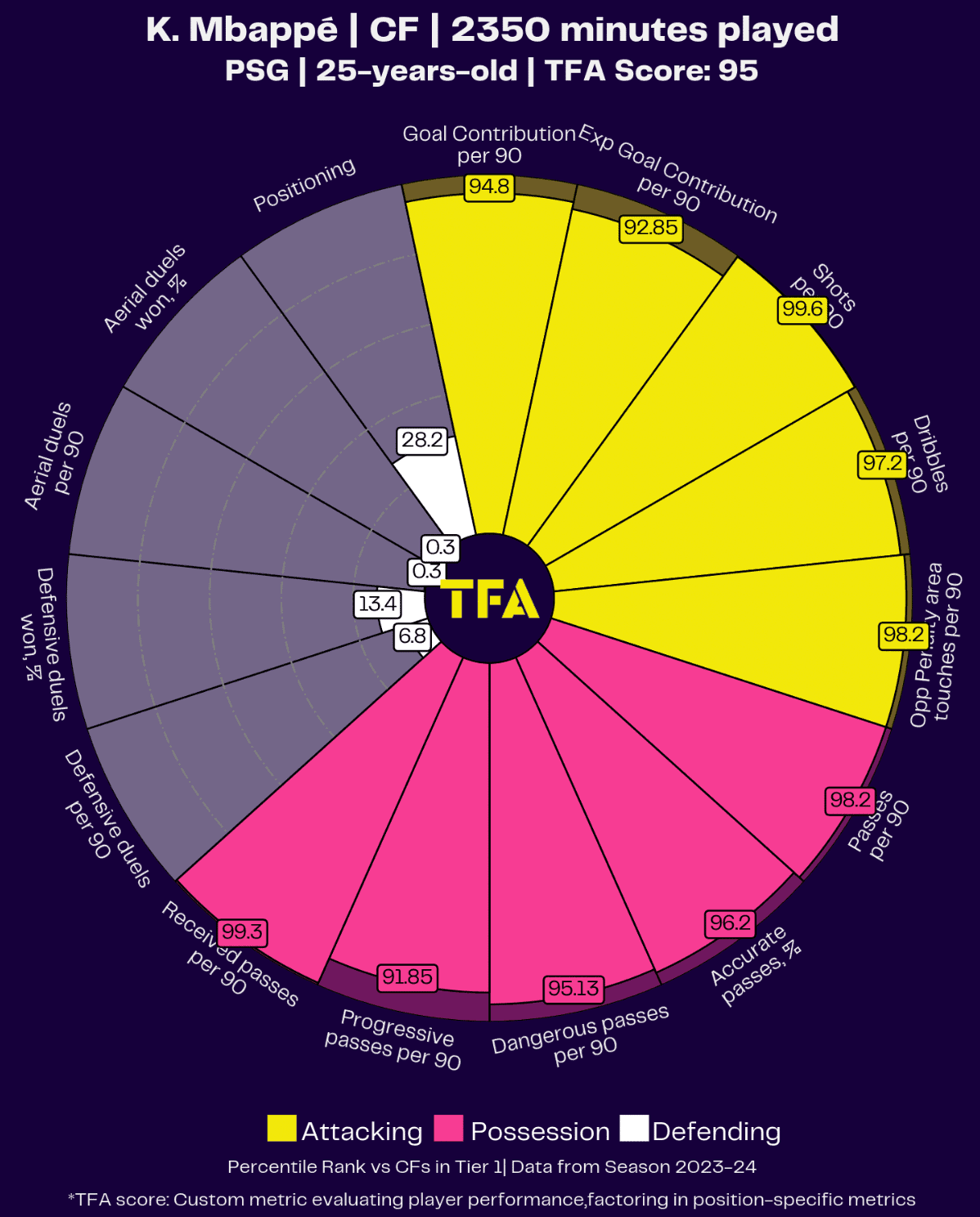
Looking at Mbappé’s performance last season, he effectively performed at an extremely elite level in all attacking and possession metrics on our pizza chart when compared with centre-forwards from Europe’s top-five leagues, emphasising his highly influential role in PSG’s attack.
Most of Les Parisiens’ attacks went through Mbappé in some form, whether that was with the Frenchman dropping from a centre-forward position and receiving to feet in something of a ‘false 9’ role, drifting out to the wings and receiving with a view to taking on a defender 1v1 or looking for a ball in behind from central or out wide against a high line — all notable moves in this world-class attacker’s game.
However, needless to say, Mbappé offers little defensive contribution, as his poor numbers in that particular area show.
Bradley Barcola Radar Map
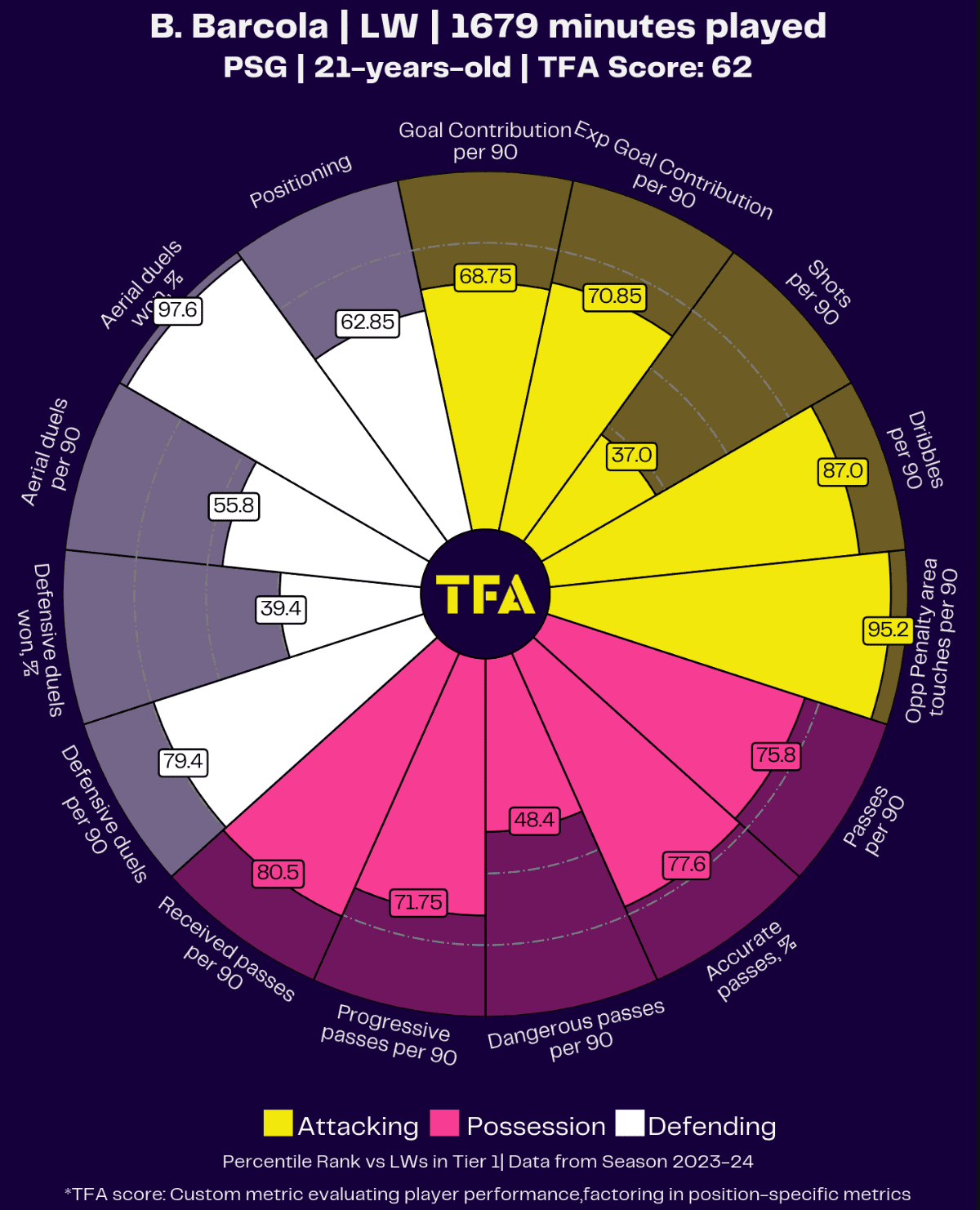
Barcola’s numbers for last season from the left, though pretty solid overall, pale in comparison to Mbappé’s mind-boggling statistics.
While he had a relatively high volume of dribbles, touches inside the opponent’s box, and overall involvement in possession, Barcola presented a noticeable drop in shot volume and dangerous passes compared to Mbappé.
At the same time, Barcola offers far more without the ball, presenting a dynamic different from that of Mbappé to PSG’s forward line.
So far, during his second season in PSG colours, Barcola has stepped up certain areas of his game following Mbappé’s move.
Notably, he’s increased his shot volume so far this term by more than double last season’s numbers.
At present, Barcola is taking 3.56 shots per 90 in the 2024/25 Ligue 1 campaign compared with 1.62 per 90 in 2023/24.
Barcola is still fairly active in defensive phases while remaining a high-volume dribbler, but alongside his shot increase, the attacker is creating more threat, with about twice as many expected goal contributions per 90 this term (0.91) than last term (0.46).
This is where his role has primarily evolved in 2024/25, as he’s using his skills to directly contribute to the team’s goalscoring and chance creation more this term with no Mbappé in the team’s attacking dynamics.
So far, it’s hard to speak negatively about Barcola’s role in this adaptation period, given he’s Ligue 1’s highest scorer in 2024/25 at the time of writing, with six goals in six games.
Bradley Barcola Scouting Report At PSG 2024/25
Barcola’s shot selection and movement are currently at the highest level in the former Lyon man’s career.
Bradley Barcola Shots Map 2023/2024 vs 2024/2025
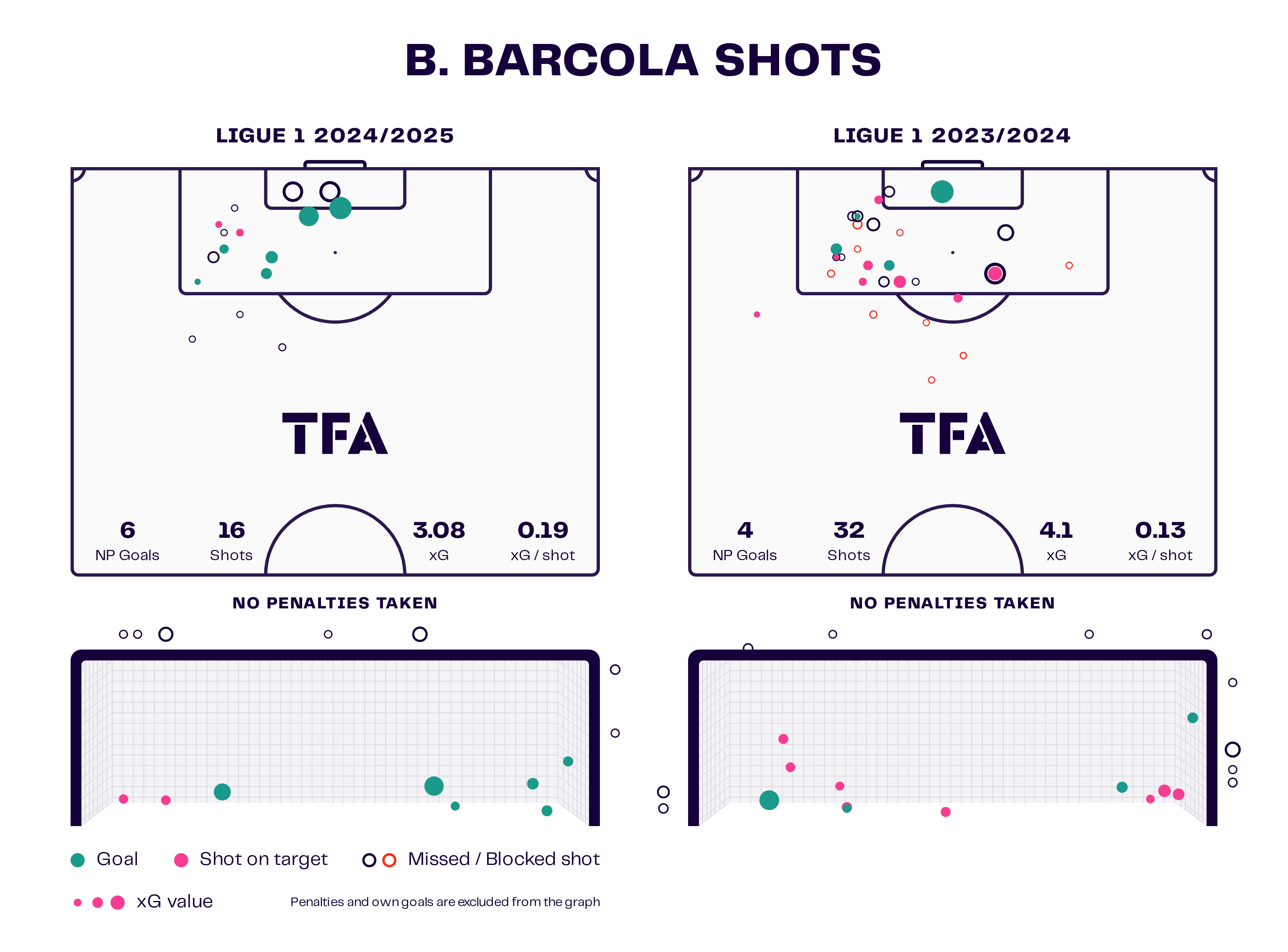
Firstly, let’s take a look at figure 3 above, where we can see the 22-year-old’s shot map from the first six league games of this season compared with the entirety of last season, in which he took twice as many shots as he has so far this term but scored two fewer goals than he already has at this stage of the 2024/25 campaign.
Though he’s taking a far higher volume of shots this season than last term, he’s been far more selective with his attempts on goal in the sense that he’s taking on a smaller proportion of low-percentage efforts.
Barcola’s not just shooting more in 2024/25; he’s enjoying more opportunities in high-quality positions.
This is a result of the shift in PSG’s attacking dynamics with Mbappé out of the picture, which has led to Barcola having first dibs on those high-value areas.
Kylian Mbappé Shots Map 2019/2020
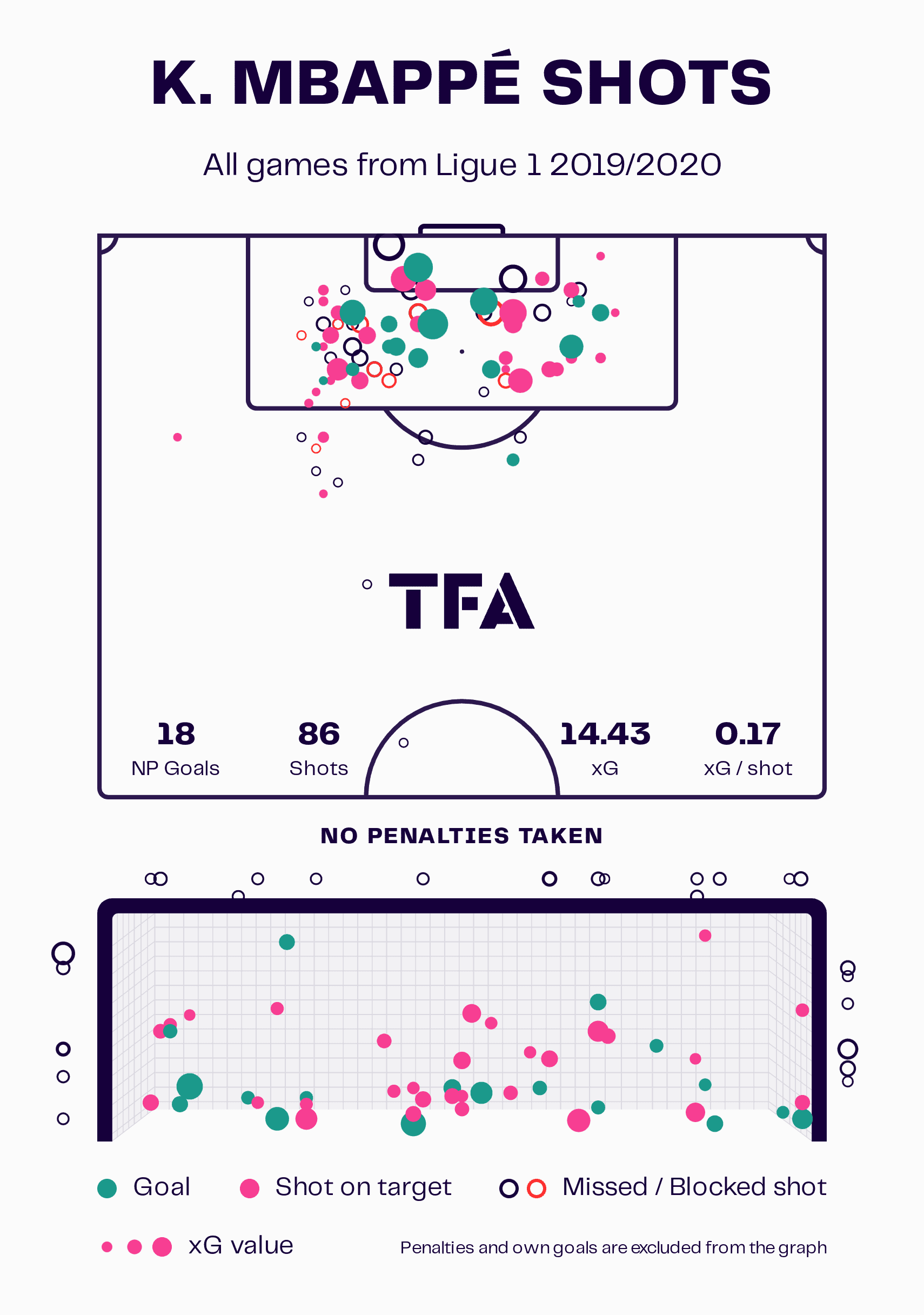
Still, Barcola’s shot-taking differs from Mbappé in that he is purely a left inside forward.
In contrast, Mbappé occupied central positions more often and drifted all across the forward line, resulting in plenty of shots from the right as well as the left.
Bradley Barcola Shots Map 2022/2023
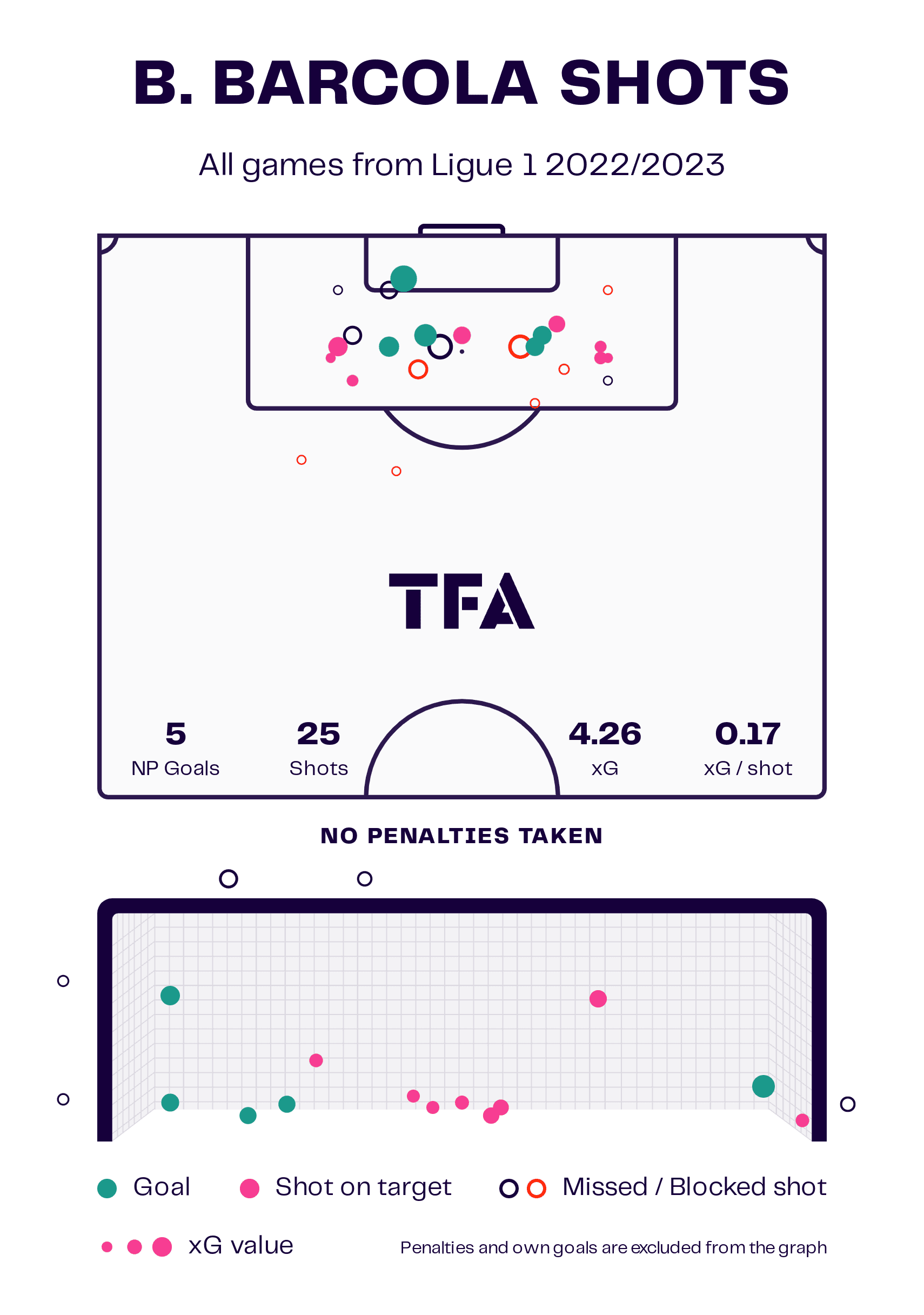
Barcola could evolve in a similar way.
He also showed his ability from the right during his major Ligue 1 breakout campaign with Lyon in 2022/23.
Note how his xG per shot was higher in 2022/23 than in 2023/24; the young forward demonstrated his potential to lead a forward line at the very top of the division during the 2022/23 season and is showcasing this once more, though now as a more mature player, with Ligue 1’s best side in 2024/25.
Barcola is demonstrating vastly improved movement and positioning this season compared to the past.
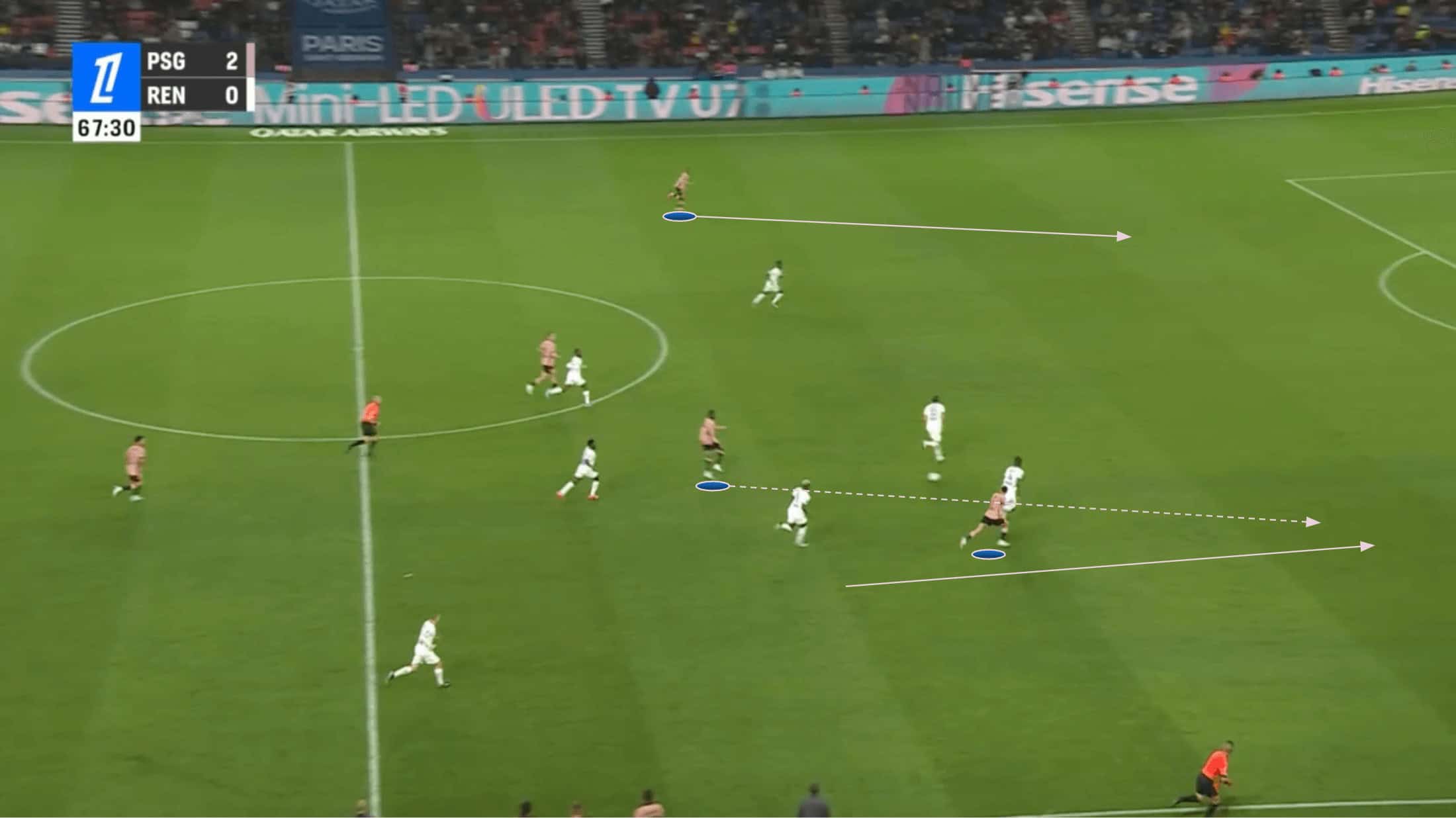
These two images versus Rennes show an example of how Barcola has been finding and attacking space very well from the left in 2024/25.
Firstly, above, we see PSG counterattacking on the right, with space for Barcola to sprint into behind the defence on the left.
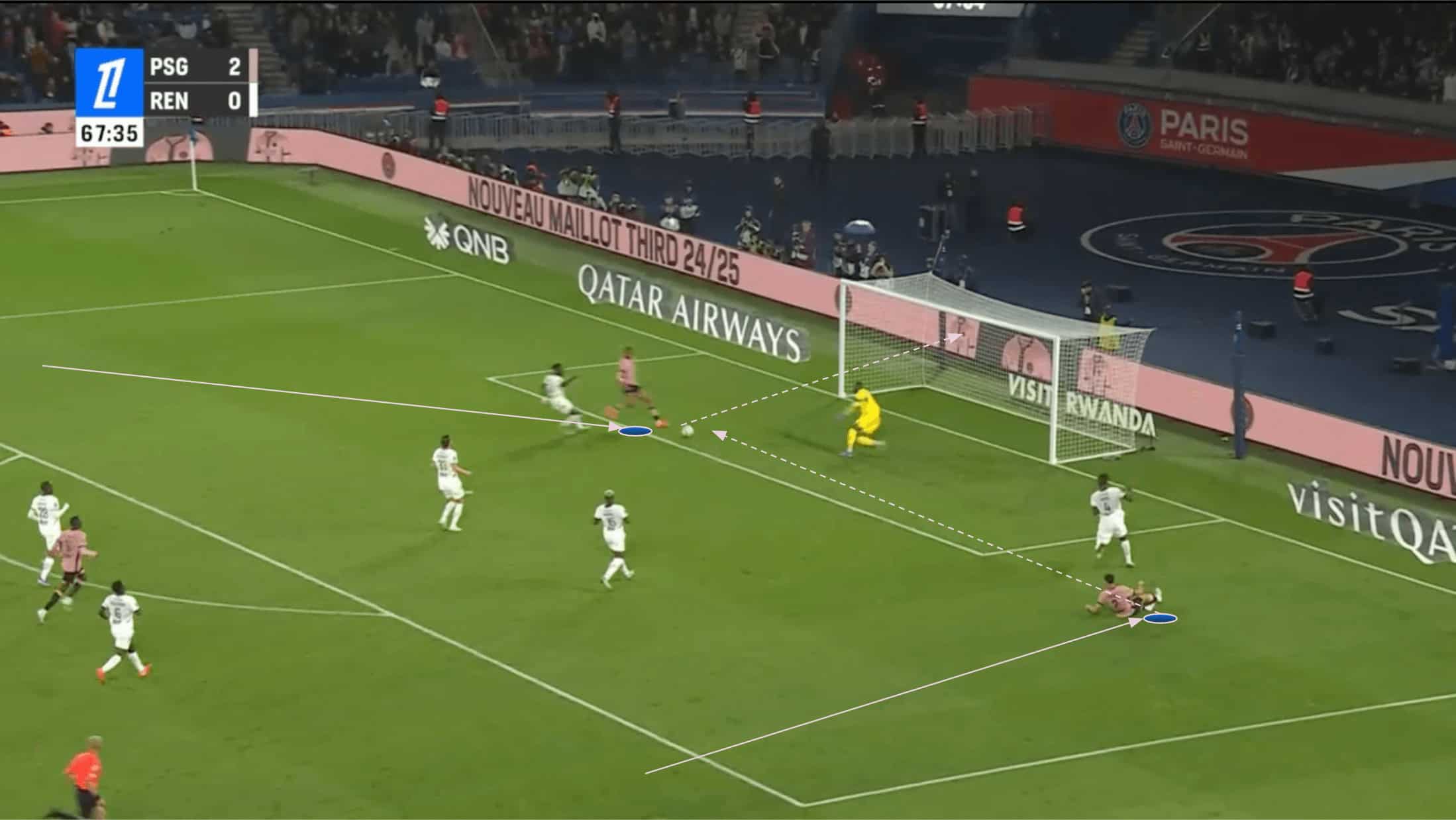
As this attack progresses, we see how Barcola got into the danger zone ahead of his marker and gave Hakimi a fantastic option to square the ball, which he gladly took.
In previous seasons, especially during his time at Lyon, one potential criticism of Barcola’s game was his tendency not to properly attack those valuable spaces in the box, instead hanging towards the edge of the box more.
This directly resulted in a more difficult job for his teammates in picking him out as well as more difficult chances for himself.
Developing this area of his game has had a significant direct influence on his higher xG per shot and, naturally, his high goalscoring numbers so far in 2024/25.
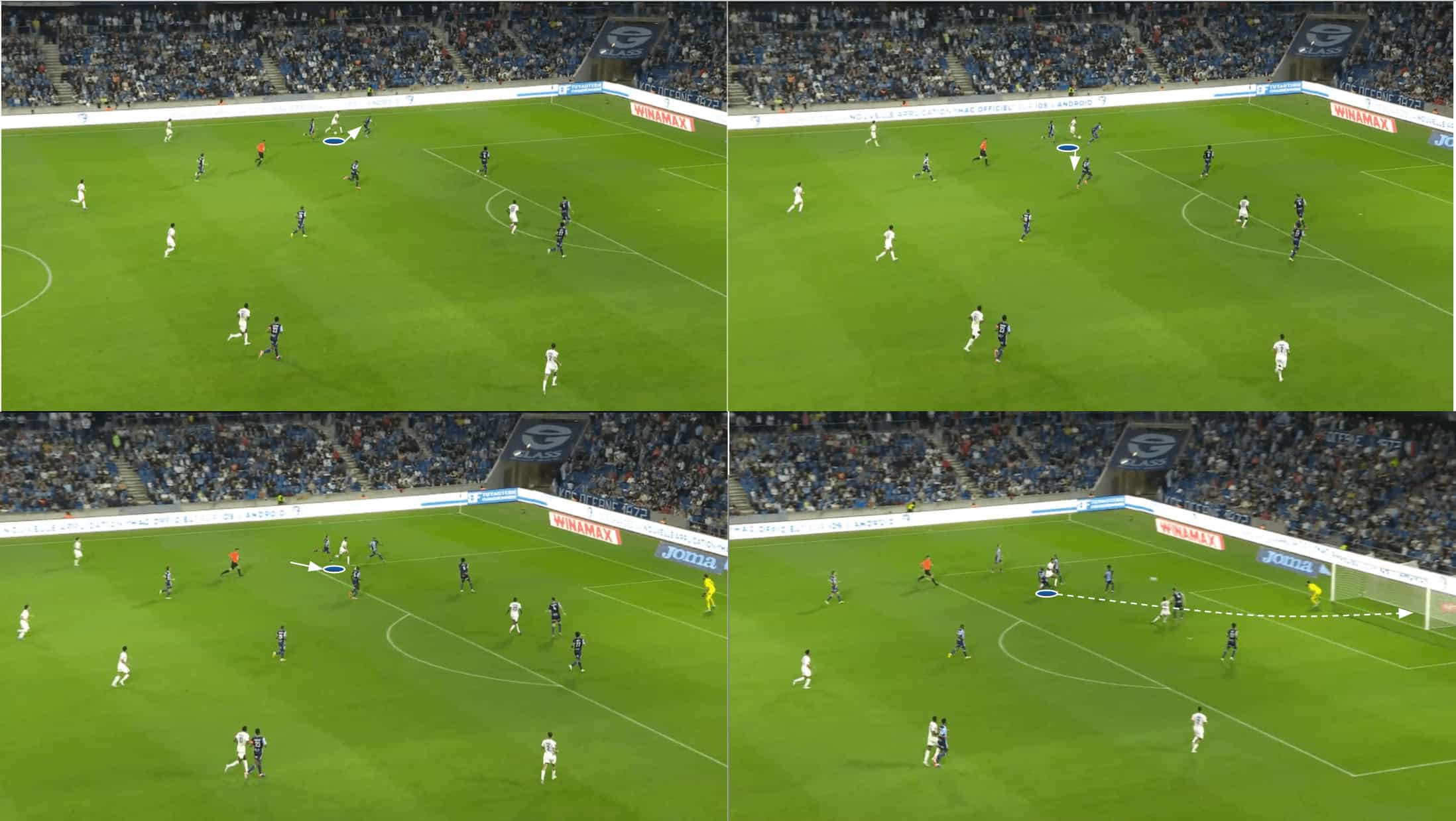
As mentioned previously, Barcola is a high-volume dribbler.
Along with his off-the-ball movement which has played an important role in the attacker’s ability to frequently avail of chances from good positions, Barcola has also been able to craft chances for himself directly as a result of his ball-carrying ability.
Take figure 8, for instance.
Here, Barcola initially begins dragging the ball to his left, influencing the defender standing him up to move similarly.
Thanks to his agility and balance, Barcola is able to quickly shift direction and target the resulting space inside the defender.
Then, it’s all about the 22-year-old’s ball control and acceleration, which help him burst past the defender, who’s been completely wrong-footed by the PSG man’s dribbling, as Barcola drives into a great shooting position.
The attacker curls the ball towards the far post with the inside of his right boot, putting it past the goalkeeper and into the far corner of the net with a finish that’s becoming something of a signature in his game.
Barcola is excellent at opening his body up when he comes inside from the left and bending the ball in at this type of angle, even under pressure and with obstacles to shoot around, as we see above.
This has undoubtedly been one of the most effective weapons in PSG’s attack this term.
Bradley Barcola Vs Kylian Mbappé Heat Map
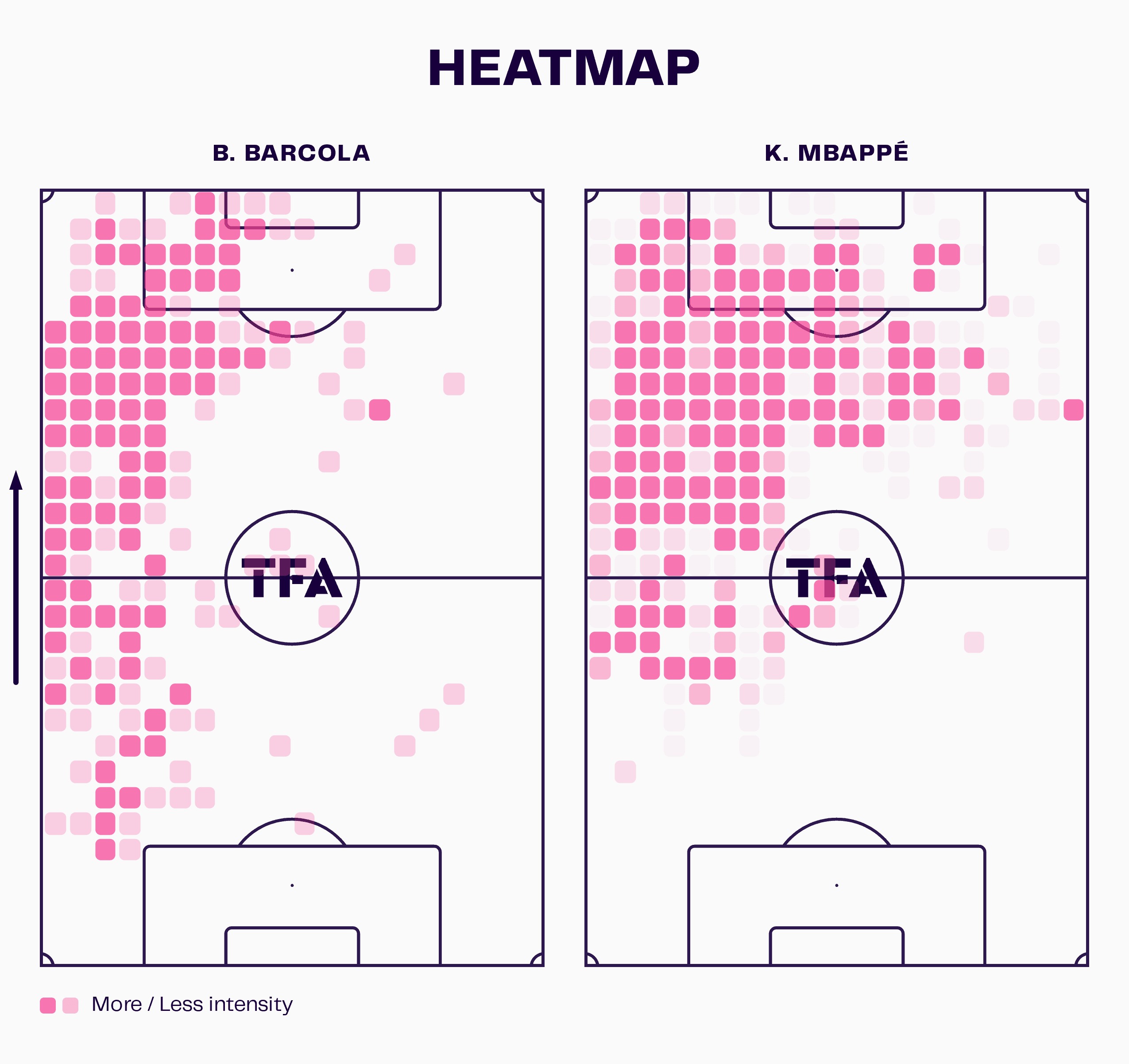
Though Mbappé primarily played as a centre-forward last term, he frequently drifted out to the wings, especially the left wing.
This sees Barcola, this term, often occupying similar positions to the ones we saw Mbappé occupying last season.
However, Barcola tends to drop deeper to receive than Mbappé generally did, which is also evident from their respective heatmaps.
As he drops deep to receive with his back to goal, Barcola tends to draw attention tight to his back from an opposition marker.
This clears the path for the young attacker to pull off another signature move in his game — a quick one-two with a nearby teammate to release himself in behind his marker.
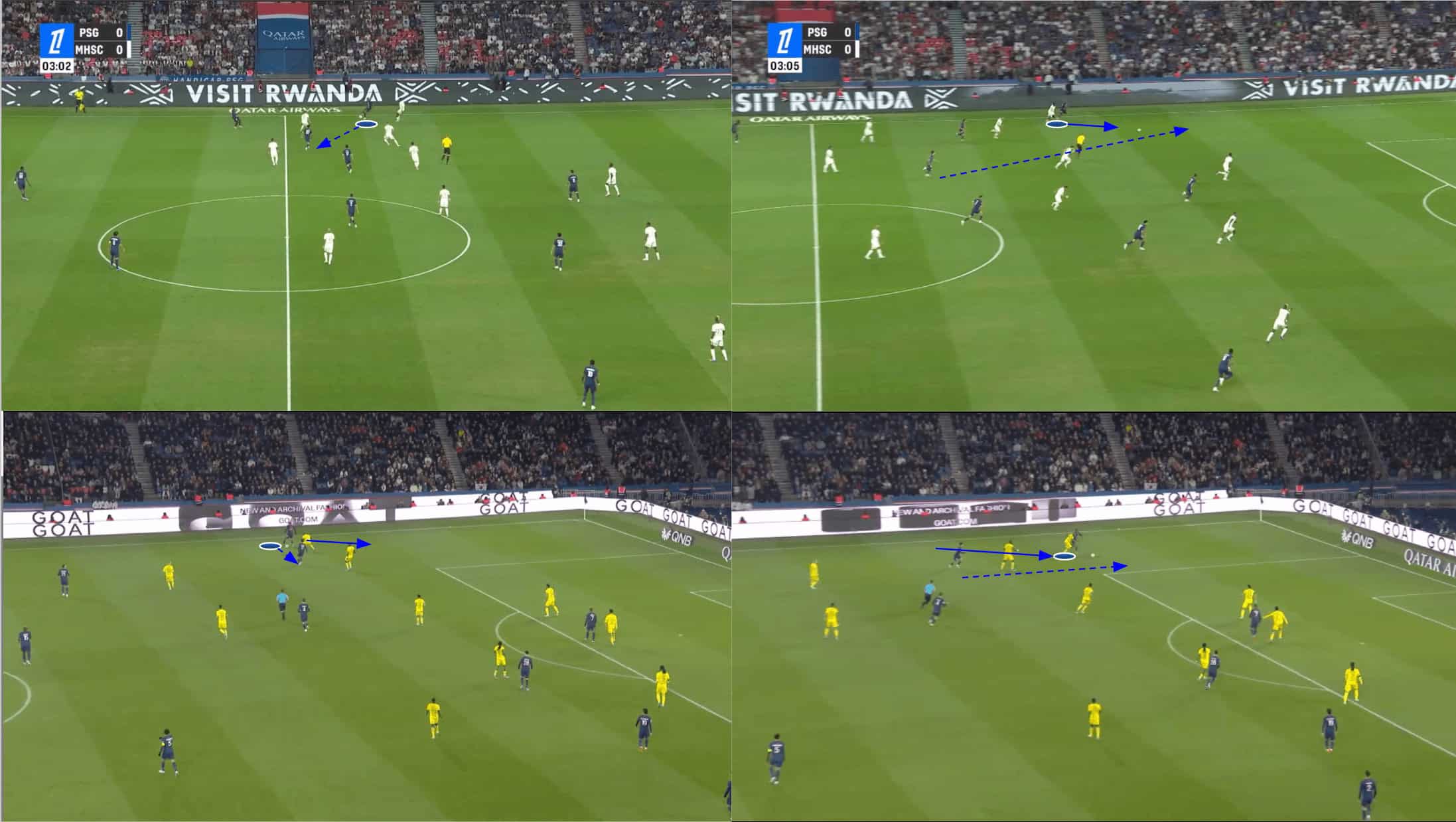
Above, in the top two images, we see an example of Barcola pulling off his one-two from just ahead of the halfway line.
As he initially receives, the opposition full-back closes Barcola down.
This prompts the winger to play the ball to a teammate inside before swiftly turning and darting in behind his marker.
Then, the ball carrier can release the speedy winger into space, as the top-right image above demonstrates.
In the bottom two images, Barcola is positioned slightly higher, but the principle remains the same—he receives and draws a defender, creating space behind that opponent that can be exploited via a one-two.
Like Barcola’s dribbling quality analysed above, this move relies on the PSG winger’s elite agility, balance and acceleration.
This move has proven successful on several occasions this term, resulting in plenty of chance creation for Les Parisiens.
João Neves Scouting Report At PSG 2024/25
Another player who’s played a significant role in the evolution of PSG’s attack this season is João Neves, who joined the Ligue 1 side from Benfica for reportedly just under €60m this past summer.
João Neves Radar Map
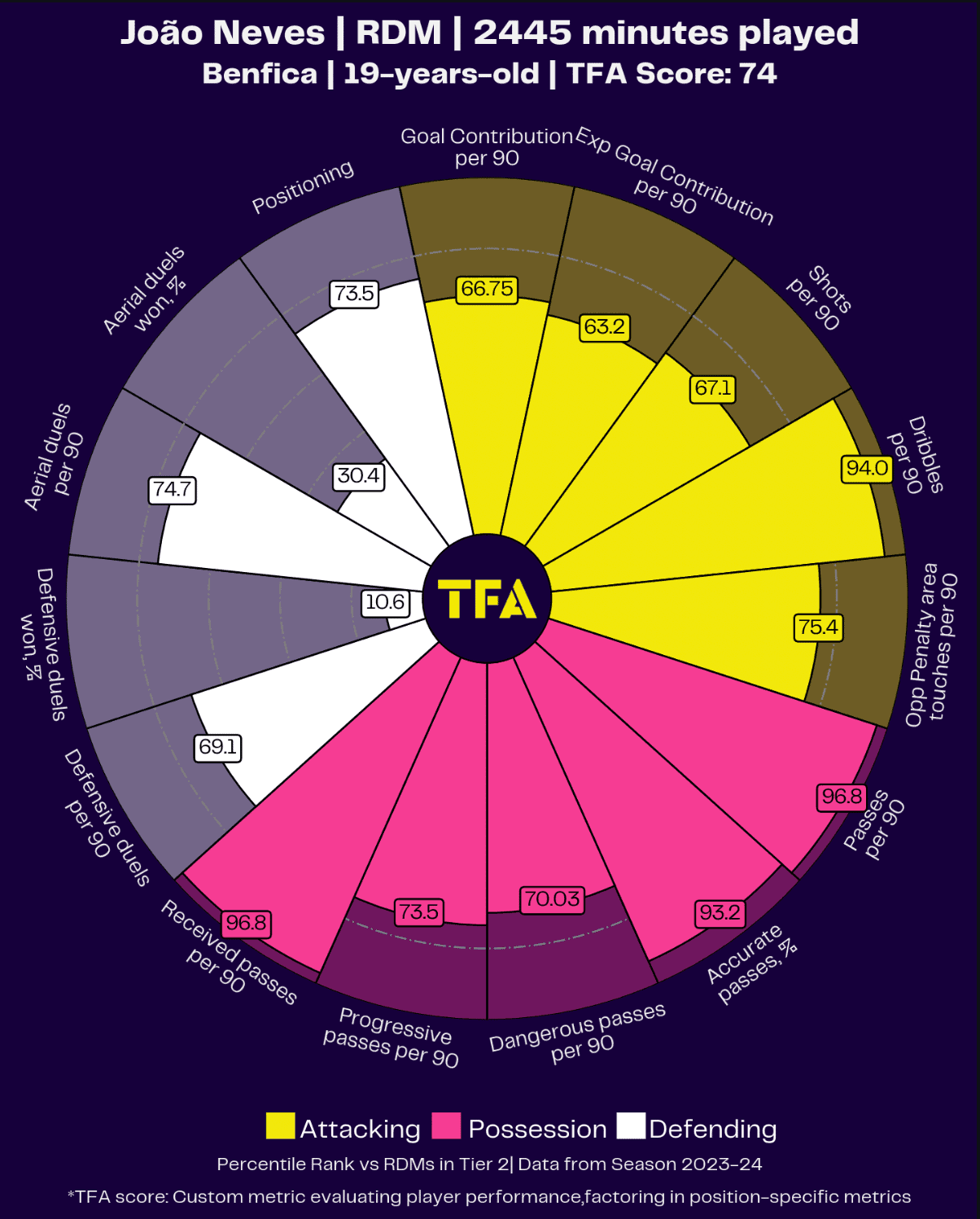
Neves emerged as one of Europe’s most wanted midfielders last season during a vital career development season with Benfica.
His profile is that of a fairly well-rounded midfielder who’ll contribute plenty in defence, attack, and possession.
He has notable strengths in chance creation, ball-carrying, and possession retention.
João Neves Heat Map 2024/2025
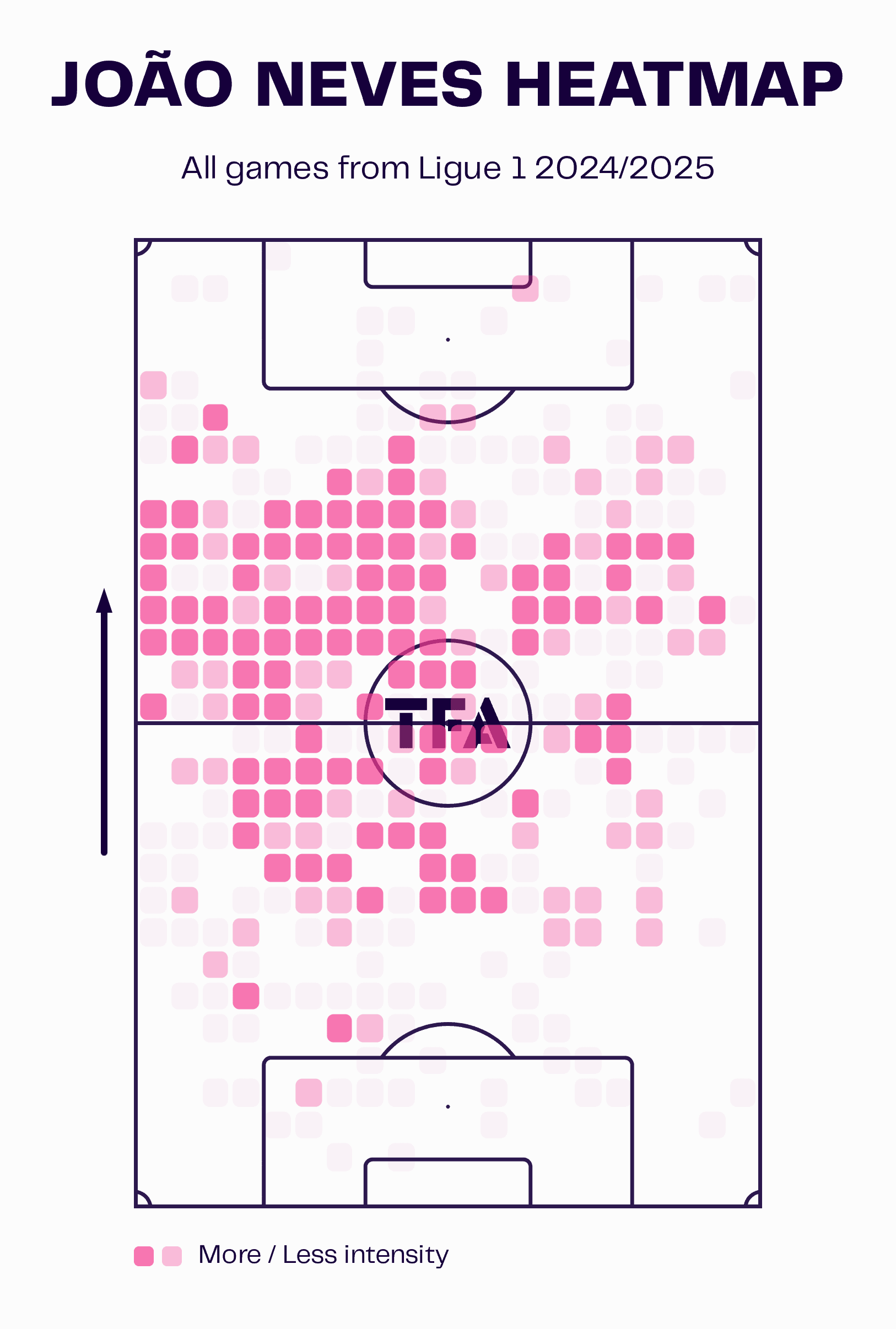
This term, Neves has settled in nicely on the left of PSG’s three-man central midfield.
He’s comfortable rotating with his central midfield partners and will sometimes swap into the deeper midfield position, from where he’s well able to dictate play and spread the ball around the pitch.
Similarly, the versatile 20-year-old will sometimes rotate out onto the left wing in the chance creation phase, allowing Barcola to move into the half-space earlier and create a new offensive dynamic for the opponent to contend with.
João Neves Assists Map 2024/2025
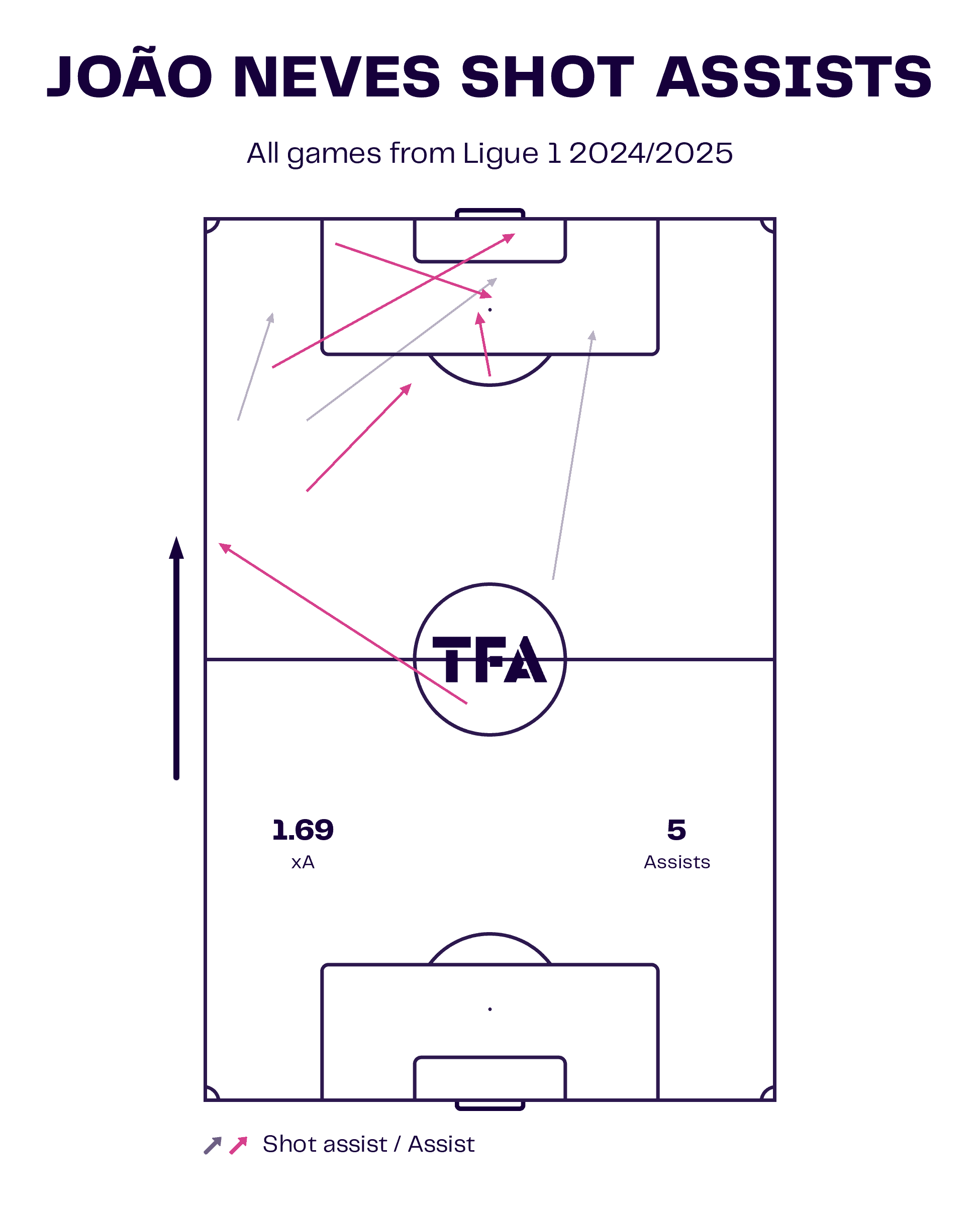
At the time of writing, Neves is Ligue 1’s top assist provider, with five to his name in six games.
Some of his assists have come from central positions, while others have come from the left, where he’s often found drifting as described above; the midfielder is excellent at spotting space he can move into and exploit in possession.
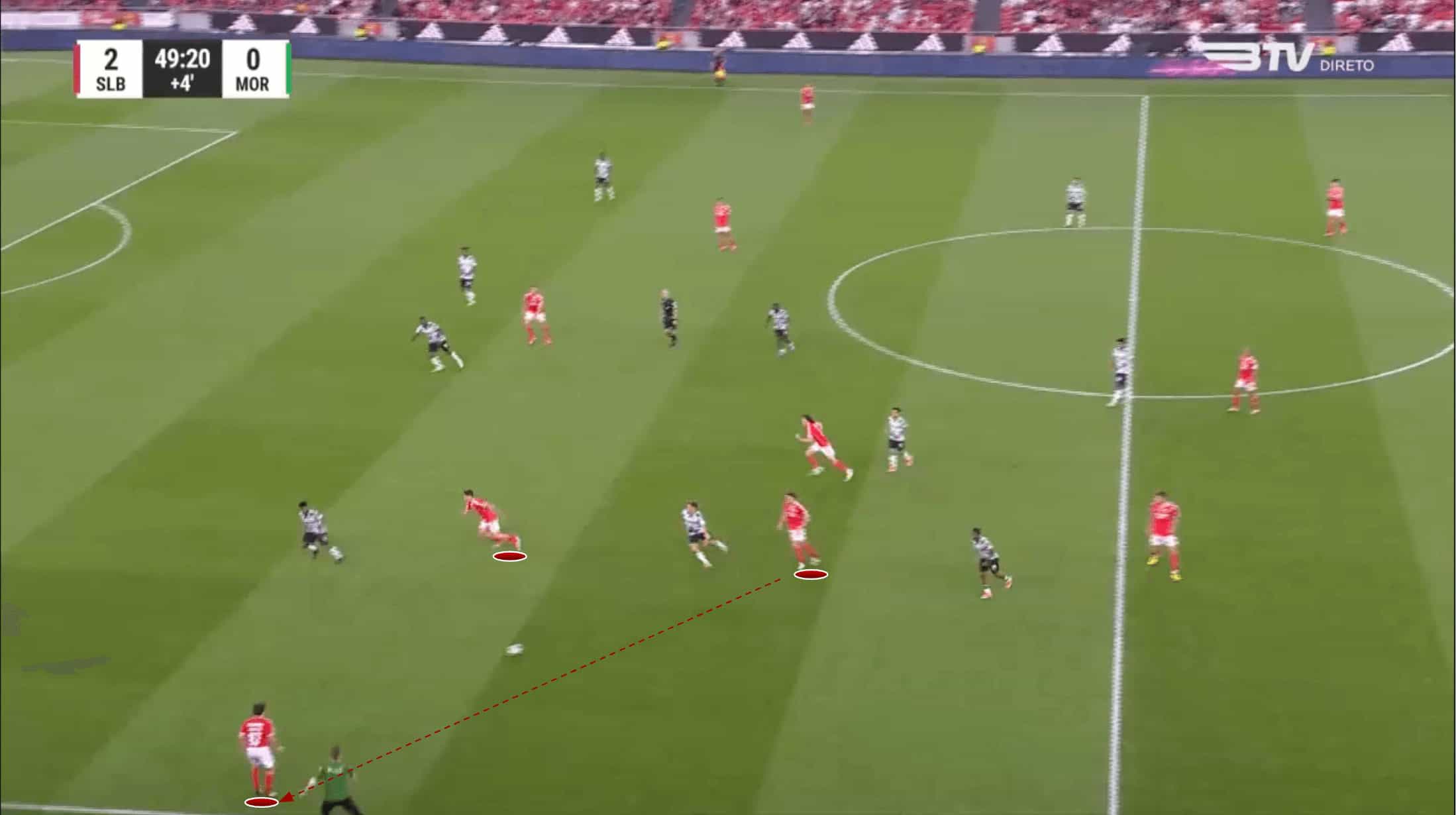
PSG will have been well aware of Neves’ tendency to drift out to the wing in attack when they signed him, as this movement was also evident in his game at Benfica last term.
Take figure 14, for example, where Neves provides the width for the Portuguese side on the left wing.
He enjoys plenty of space here as the opposition full-back is preoccupied with the winger, who’s now moved inside to the half-space.
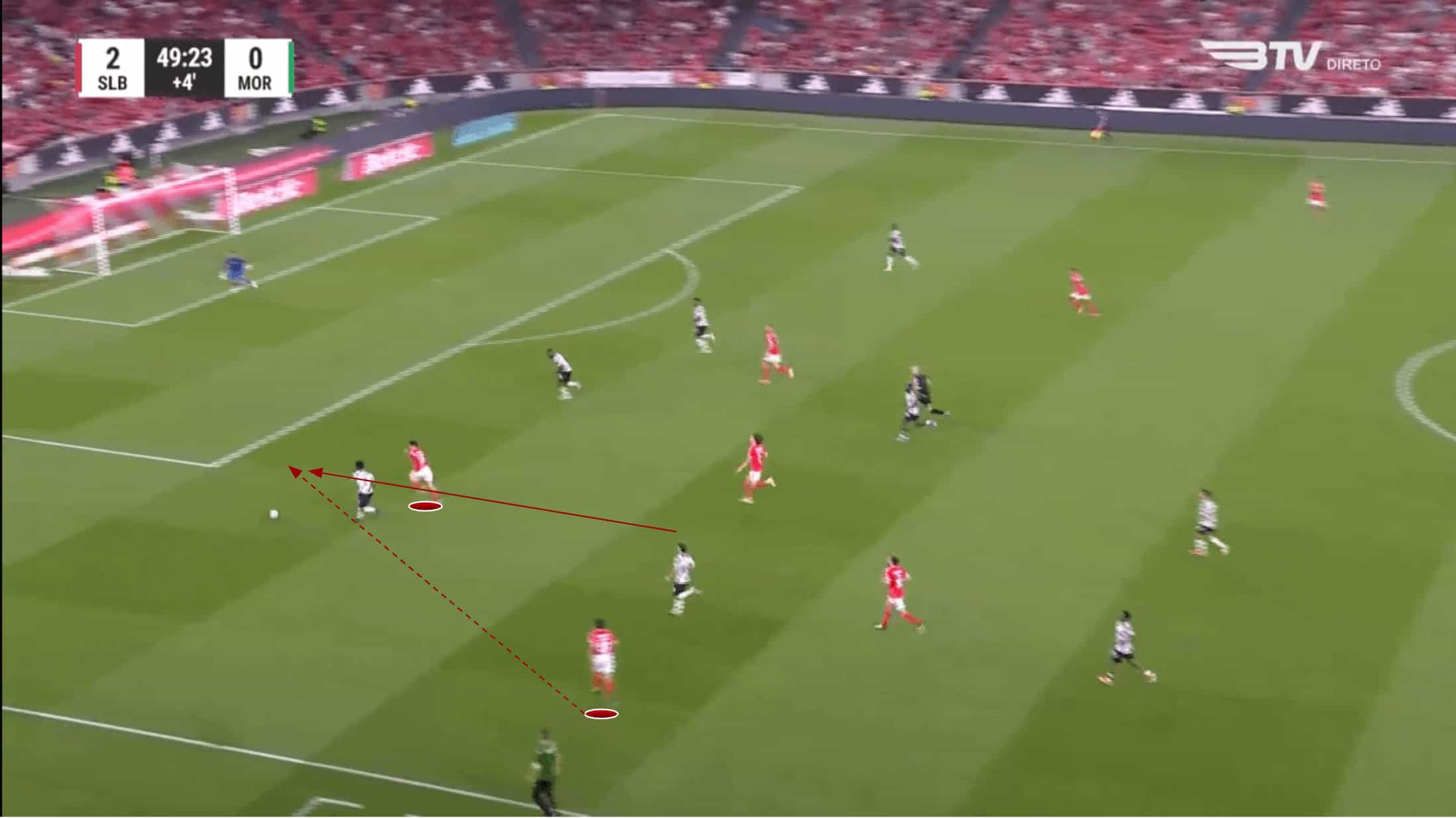
Neves is lethal when given that much time and space to pick out his pass.
As this passage of play moves on, we see how the midfielder managed to play an excellent ball in behind the defence for his left-wing teammate, highlighting the benefit of this rotation that freed up Neves on the edge of the final third.
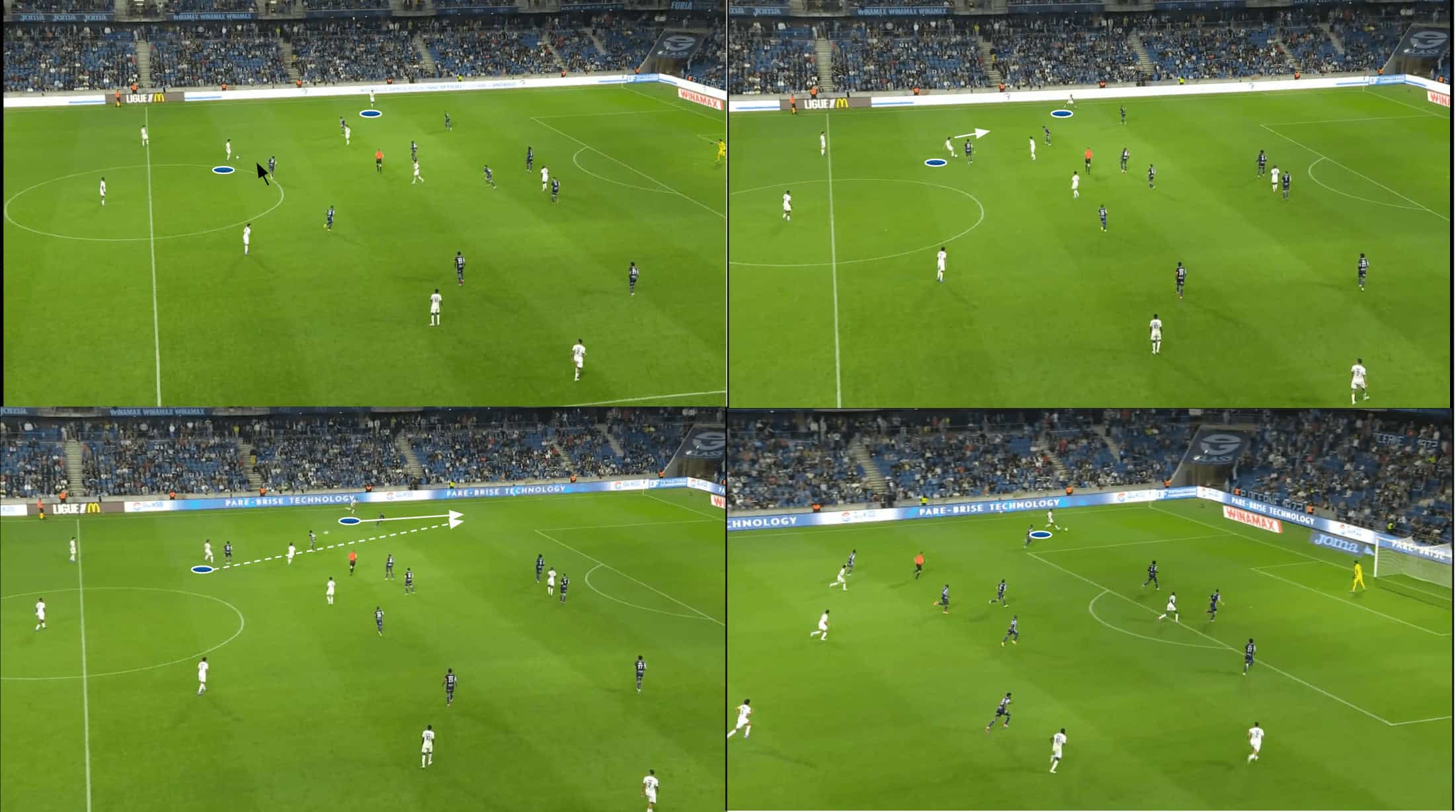
As mentioned earlier, Neves is also comfortable dropping deep and dictating play from just in front of the centre-backs.
The midfielder’s vision plays a key role in this element of his game — see figure 16 for an example.
Here, Neves picks up the ball deep and takes his time to make his next move.
He gets his head up and surveys the layout of the pitch ahead of him.
Just before the pressing opponent reaches him, Barcola begins making his run in behind, and Neves reacts by playing his through pass.
Ultimately, this was all perfectly timed, and Barcola could advance the attack from the left wing.
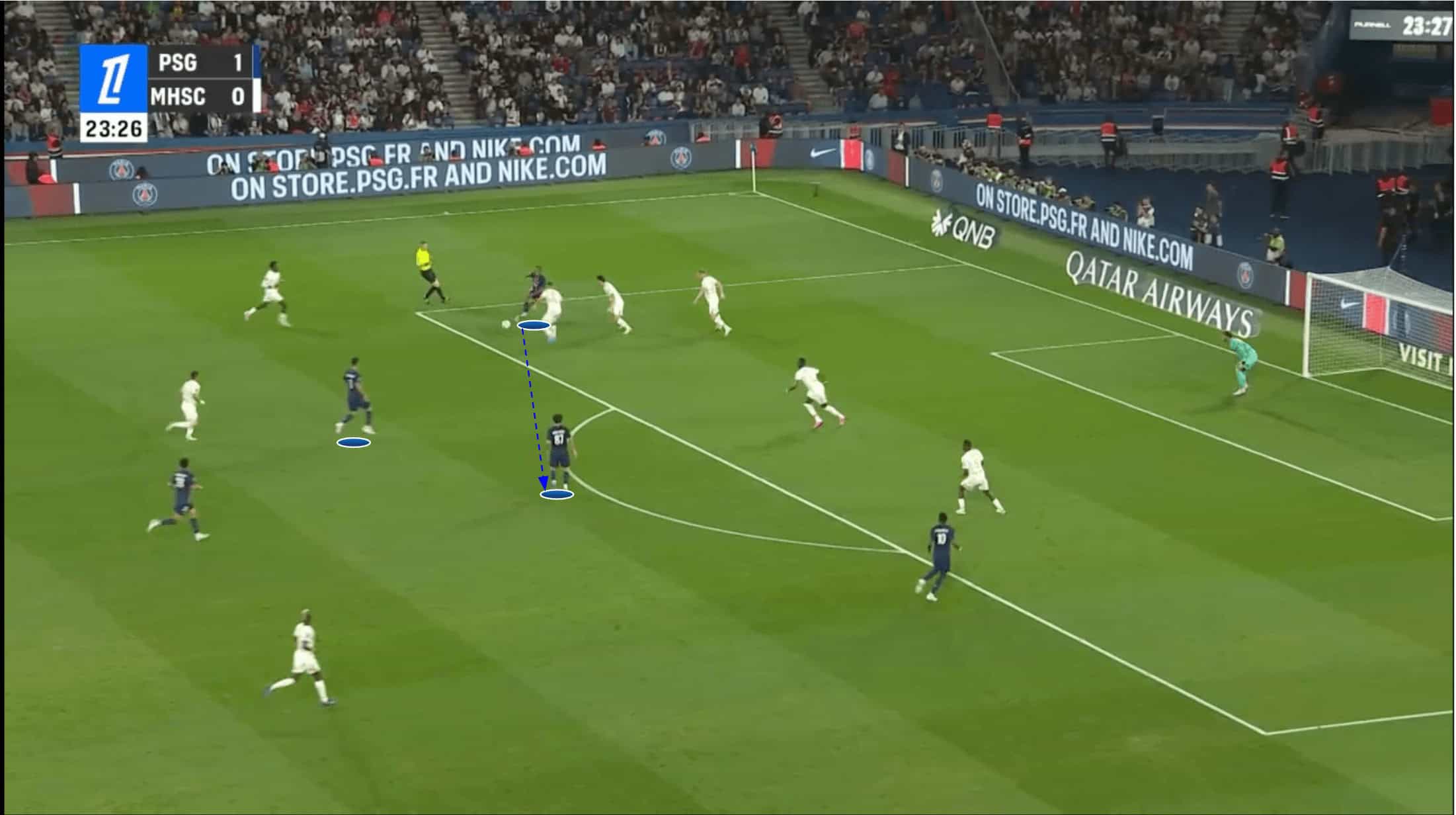
This versatile creator is definitely not limited by position.
The dynamics of PSG’s attacking tactics in 2024/25 allow him to drift around and pop up in different positions throughout the game to use his diverse creative tools.
Figure 17 shows Neves getting ready to receive in space in ‘zone 14’, where you’d typically find a ‘10’ operating.
We frequently found Mbappé operating in this position last season, but Neves has managed to make his presence felt in it quite a bit this term.
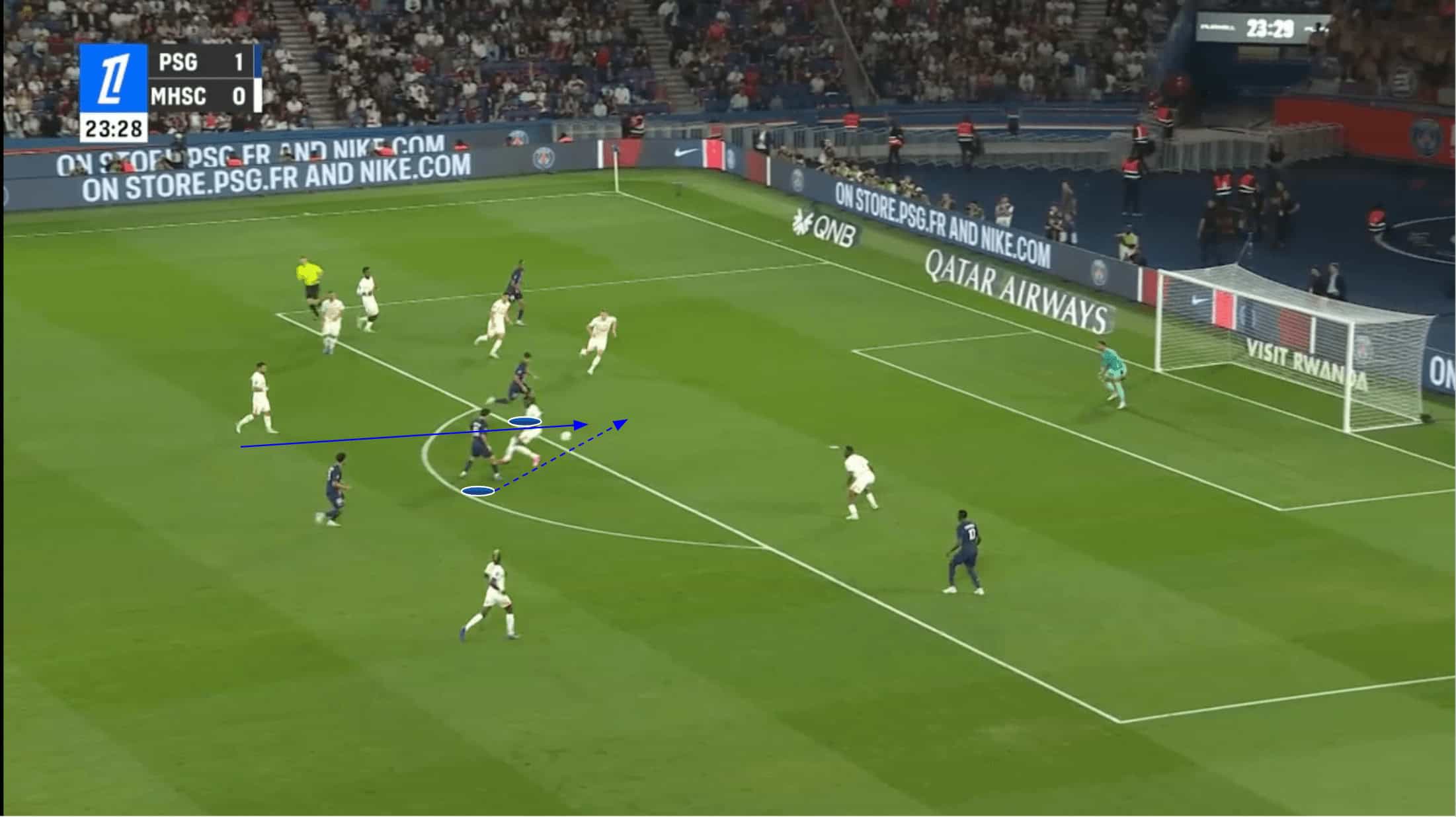
As Neves receives, the opposition centre-back steps out to close him down, but as we saw when the midfielder was operating deep, he is very comfortable under pressure.
Neves plays a quick through pass for Marco Asensio to run onto and finish off this attack.
Asensio was arriving from a left central midfield position here despite starting as PSG’s main centre-forward in this game — again, a result of the positional rotations Enrique seems to be encouraging his side to perform in 2024/25.
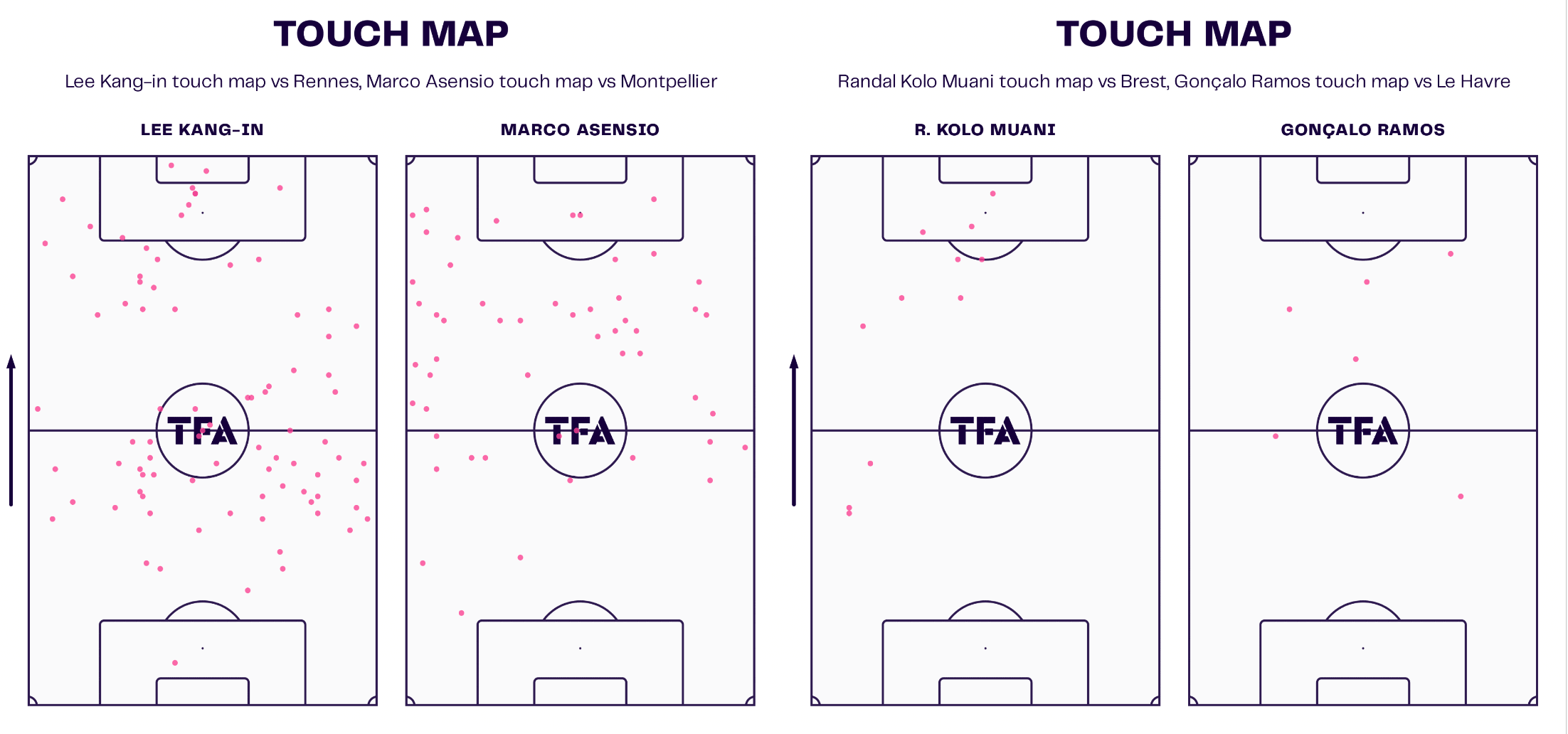
While Mbappé was mainly PSG’s centre-forward last season, this term has seen several players perform the role as Enrique experiments with the optimal attacking dynamics.
This is one element of his tactics that is yet to be finalised for 2024/25.
On the left of figure 19, we see how Lee Kang-in and Marco Asensio adapted this role versus Rennes and Montpellier, respectively, with the pair getting involved in PSG’s possession play quite a bit, often rotating with midfielders and wingers while dropping out of the forward line to receive to feet in the ilk of a ‘false 9’ a lot throughout the game.
This was what had happened with Asensio just before figure 17 above, as he switched positions with Neves, allowing both men to find space in the final third, leading to PSG’s second goal of that particular game.
We see the contrast on the right when Randal Kolo Muani and Gonçalo Ramos performed the centre-forward role for PSG versus Brest and Le Havre, respectively.
These attackers were far less involved in the team’s possession play and preferred to do their actions off the ball in chance creation, providing an entirely different dynamic for the midfielders and wingers to work with.
Conclusion
To conclude this tactical analysis and team-focused scout report, Bradley Barcola and João Neves have clearly played a significant role in shaping PSG’s attack in the early phases of their post-Mbappé era.
While much of Barcola’s game remains similar to his role last season, he’s had to adapt his skills to directly contribute to goals more often this term.
At the same time, the arrival of Neves, who’s effectively replaced Manuel Ugarte’s completely different profile in PSG’s central trio, has added an extra dose of creativity to Les Parisiens’ midfield, replacing some of the dangerous passing which Mbappé used to contribute and Barcola doesn’t exactly provide.
Enrique is still seemingly searching for the ideal solution at centre-forward, but this early stage of the 2024/25 season has thrown up some interesting possibilities, such as using Asensio or Lee as ‘false 9s’ or Kolo Muani or Ramos as more out-and-out ‘number 9s’.

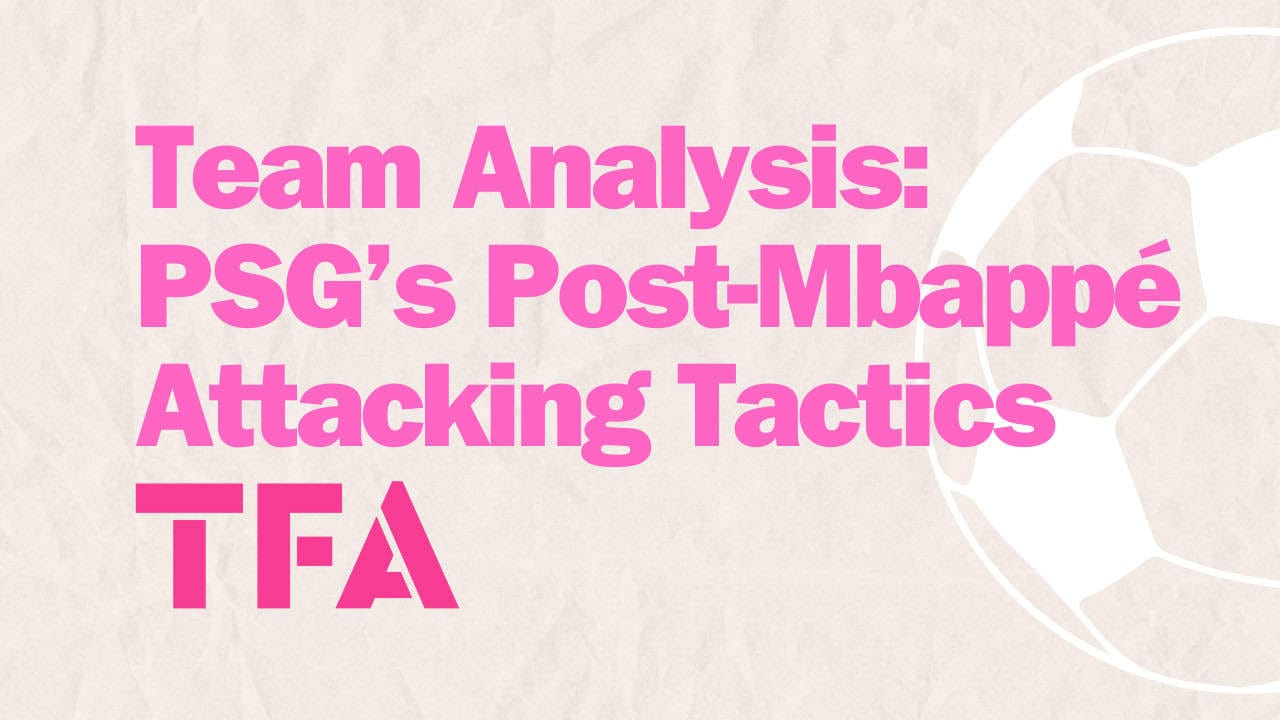



Comments